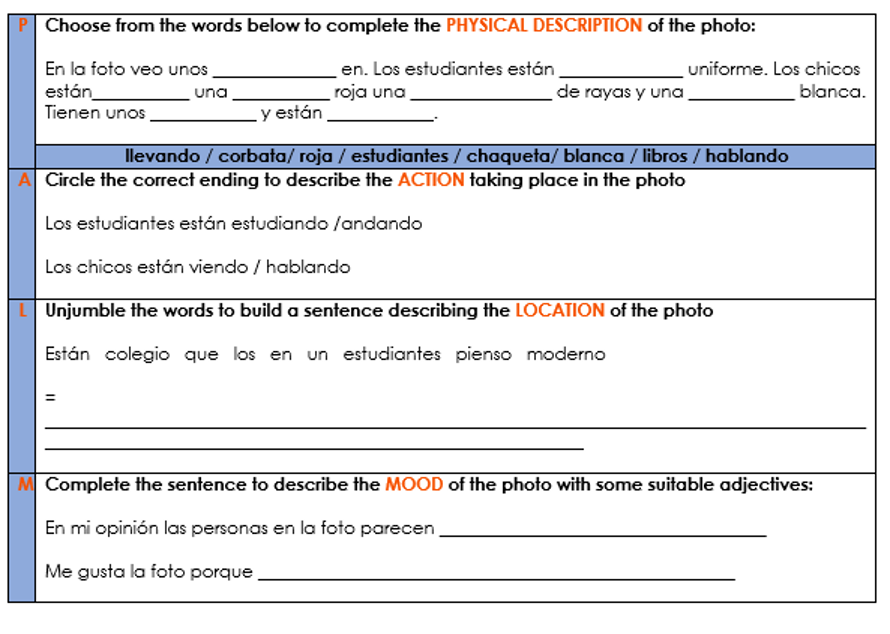
June 2021 Edition

By Neetu Sadhwani
Share
The pedagogy of Language Learning and the importance of instruction in MFL
The role of the language teacher in today’s classroom has shifted from being the expert to that of facilitator or guide with the mission of supporting students to become confident linguists by developing listening, speaking, reading and writing skills in that language, as well as enhancing their curiosity for the language and its culture.
In 2012, Barack Rosenshine published the Principles of Instruction: a set of 10 research-based principles of instruction, along with suggestions for effective classroom practice. These principles can help Modern Foreign Language teachers direct their planning and methodologies in order to achieve best levels of progress and outcomes from students. Below an example on how I have applied them to teach students how to describe a photo card, a task all language GCSE students complete during their speaking exam.
Principle 1) Begin a lesson with a short review of previous learning:
Before introducing the first question in a photo card- ‘What can you see in the photo?’ students would need reminding and revisiting of simple KS3 sentences such as ‘there is/there are’ or the present tense to describe people physically. Easy and effective ways to do this are via simple activities such as filling in the blanks or matching up English words and sentences with the equivalent French or Spanish.
Principle 2) Present new material in small steps with student practice after each step:
Once students have revisited previous knowledge that can be used for the photo card task, I present the class with their first exam photo card like the one below, by breaking down the requirements of the questions, in order to help them reduce the cognitive load. For example, to answer the first question ‘¿Que hay en la foto?- (what is there in the picture?), it is common language practice to use the acronym PALM W (People, action, location, mood, weather). Instead of presenting the acronym at once, I would teach them simple grammatical sentences for each of the elements in the acronym individually first, which will help students get to the whole description in smaller steps.


Principle 3) Ask a large number of questions and check the responses of all students:
When students are confident answering the first question, I present them with a number of questions to forecast what the other four questions on this card could be and which verb tenses would they require?
Principle 4) Provide models:
In order to support students answering the rest of the questions, which involve responses in different tenses (present, past or future) as well as a higher level of development in their language structures, I apply Rosenshine’s principle by modelling A* answers. This can be done by pairing a set of questions and answers on a power point, and then highlighting the elements that make the model answers so highly rated by examiners.
Principle 5) Guide student practice:
Students have the full photo card with all five questions in the target language and can now carefully plan written answers with feedback from me or from their peers. This helps them gain the opportunity to focus on the area that needs practice, for example a particular verb tense.
Principle 6. Check for student understanding:
Once students have produced well-guided and developed answers for all questions, I would collect them in to check that accuracy, grammar and content is correct and that no misconceptions have occurred.
Principle 7) Obtain a high success rate:
One way to do this is by adding a fun element of competition and rewarding the most developed or most original answers for this photo card.
Principle 8) Provide scaffolds for difficult tasks: The teacher provides students with temporary supports and scaffolds to assist them when they learn difficult tasks.
On the following lesson, students are presented with a new exam photo card. Before asking students to start drafting their own answers, I play a recording of an A* candidate performing the exam task and present them with a partial copy of the transcript, where they listen and fill in the gaps before creating their own responses.
Principle 9) Require and monitor independent practice:
After all the above, regularly presenting students with photo cards during classwork or homework will allow them to produce more independent, differentiated and creative responses.
Principle 10). Engage students in weekly and monthly review:
The photo card, once introduced and practised, should then become part of students’ regular class and assessment practise.
The essence of Rosenshine’s principles allows language teachers to ensure their lesson planning supports students achieve their desired goals in a language classroom by regularly reviewing, modelling and practising language skills.
